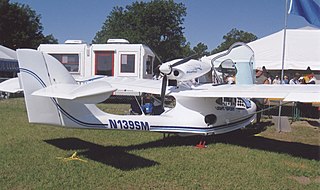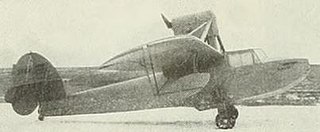
The Buccaneer is a one- or two-seat ultralight high-wing amphibious flying boat of pusher configuration marketed as a kit aircraft.

The Quikkit Glass Goose is an American two-seat biplane amphibious aircraft, designed by Tom Scott and marketed for homebuilding by Quikkit of Dallas, Texas.

The Progressive Aerodyne SeaRey is an American two-seat, single-engine, amphibious flying boat designed and manufactured by Progressive Aerodyne originally in Orlando, Florida, and now in Tavares, Florida. It was first flown in November 1992 and is sold as a kit aircraft for amateur construction as well as a light-sport aircraft.

PZL.12 (PZL-H) was a prototype of a Polish amphibious flying boat designed and built in 1931 by Zygmunt Puławski, a pioneering Polish designer. He was killed in a crash involving this design.

The Curtiss Models F made up a family of early flying boats developed in the United States in the years leading up to World War I. Widely produced, Model Fs saw service with the United States Navy under the designations C-2 through C-5, later reclassified to AB-2 through AB-5. Several examples were exported to Russia, and the type was built under license in Italy.

The Seamax M-22 is a Brazilian single-engine, amphibious light sport aircraft (LSA) and Fédération Aéronautique Internationale microlight. Originally manufactured by AirMax Construções Aeronáuticas of Jacarepaguá and called the Airmax SeaMax, since 2015 it has been built by Seamax Aircraft of Sao Paulo.
The Johansen CAJO 59 was a Danish twin-engined amphibious flying boat. Built in the late 1960s, it achieved certification but did not go into production.

The P.Z.L. 27 was a prototype airliner/mail plane designed by Zbysław Ciołkosz and constructed at P.Z.L. in 1933.
The Diehl AeroNautical XTC Hydrolight is an American amphibious flying boat ultralight aircraft that was designed and produced by Diehl AeroNautical in the 1980s.

The Fly Synthesis Catalina NG is an Italian ultralight and light-sport amphibious flying boat, designed and produced by Fly Synthesis, introduced at the Aero show held in Friedrichshafen in 2010. The aircraft is supplied as a complete ready-to-fly-aircraft.
The Mentzel Baltic Fox is a German ultralight and light-sport flying boat that was designed by Anno Claus Mentzel and produced by Ing Büro Mentzel of Prinzhöfte, certified in 2009. The aircraft is supplied as a complete ready-to-fly-aircraft, disassembled for transport.

The Microleve Corsario is a Brazilian amphibious ultralight flying boat that was designed and produced by Microleve of Rio de Janeiro. The aircraft was supplied as a kit for amateur construction.
The Progressive Aerodyne Stingray is an American homebuilt flying boat that was designed by and produced by Progressive Aerodyne of Orlando, Florida, introduced in the 1990s. When it was available the aircraft was supplied as a kit for amateur construction.
The Sea Storm is an Italian homebuilt amphibious flying boat that was designed and produced by Storm Aircraft of Sabaudia. Storm Aircraft was originally called SG Aviation srl. When it was available the aircraft was supplied as a kit for amateur construction.

The Caproni Ca.95 was a large, three engine, long range, heavy bomber prototype built in Italy in 1929. It could carry a 1,600 kg (3,500 lb) bomb load and had three defensive gun positions. Only one was built.

The Lioré et Olivier LeO H-23 was a French military flying boat, primarily intended for coastal reconnaissance, though able to carry a small bomb load. Only one was built.
The Sunward STB is a Chinese amphibious ultralight trike, designed and produced by Sunward Tech of Zhuzhou. The aircraft is supplied complete and ready-to-fly.
The Moskalyev SAM-11 was an amphibious version of the SAM-5bis-2, with a flying boat hull, retractable landing gear and raised engine and tail to avoid spray. Only one was built.

The Miami Maid was a US three passenger amphibian first flown in 1929. Despite ambitious production plans, only two were built.

The Argonaut Pirate was a 1930s, U.S., three place, single-engined pusher configuration amphibious aircraft. Only two were built.













